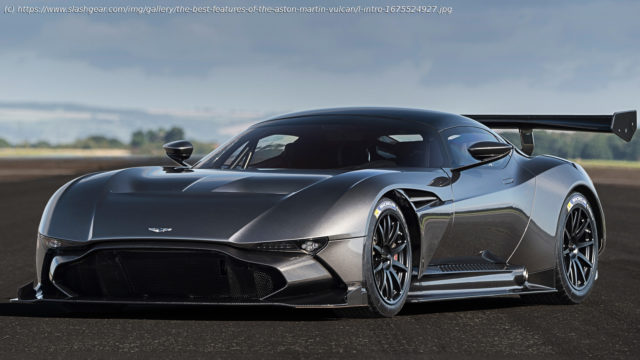Aston Martin has a long history of producing groundbreaking cars, culminating today in the Vulcan. These are the best features of the Aston Martin Vulcan.
Aston Martin has a long history of producing groundbreaking cars, from the stunning classic DBR1 to the cutting-edge One-77 supercar. The One-77 was limited to just 77 examples, hence its name. Since then, however, the British outfit has built a number of further special edition cars based on its platform. One of those specials is the Vulcan, a track-only hypercar that combines elements of Aston Martin’s racing program with the bones of its most exclusive road car.
The task for the Vulcan was simply to let the company’s design teams loose to create something that didn’t have to conform to any particular set of regulations. Since it’s not road legal, there are no emissions or design regulations to worry about, and since it’s not made for any particular racing series, there were no limits set on its power output. The result is one of the most extreme track day toys of the past decade, with even Aston Martin’s press release calling it the company’s «wildest ever car.»
The Vulcan might be a milestone in Aston Martin’s history of making track cars, but it was conceived partly by chance. The Vulcan’s chassis, sub-frames, and suspension layout carried over from the One-77, and Top Gear reports that the only reason Aston Martin decided to make the Vulcan in the first place was because they had some spare One-77 development chassis lying around.
Originally, the plan was to make a faster version of the One-77, a sort of «One-77 R,» but as development of the car progressed, it evolved into an entirely new beast. The design team proposed an entirely carbon fiber body shell instead of the original car’s aluminum panels, and Aston Martin’s racing division came up with the idea of replacing the One-77’s stock V12 with a modified version of the V12 found in the Vantage GT3 race car. By that point, the car was something altogether different from the original One-77, and so the decision was made to christen the new car the «Vulcan.» According to Aston Martin, the name was taken from a 1950s British bomber aircraft, which fittingly, made its last-ever flight within a few weeks of its hypercar namesake’s debut.
While the car’s V12 engine was taken from the Vantage GT3 racer, it underwent a number of changes before Aston Martin’s engineers got the green light to put it in the Vulcan. The standard GT3 V12 featured a displacement of 6 liters, but an extra liter of displacement was added for the Vulcan engine (via Top Gear). This helped the team reach a total power output of 820 horsepower for the car, although drivers don’t have to use all of that power on the track. Instead, there are three options that can be selected via a rotary controller on the dash: 550 horsepower, 675 horsepower, or the full amount.
With no noise regulations to adhere to, the Vulcan’s engine emits one of the most visceral soundtracks of any Aston Martin to date. It’s very much a theatrical experience as well as simply a lap-time crunching machine, both for the driver and for any onlookers lucky enough to see the car in action. However, anyone getting close to the Vulcan for a long period of time should bring suitable ear protection — at full throttle, the car emits 118dB of noise, according to Autocar. For reference, that’s around the same as the average rock concert.
While the Vulcan isn’t specifically designed for any racing series, the chassis built by Aston Martin’s partner Multimatic does feature an FIA-compliant steel roll cage and there’s race-spec suspension to handle all the downforce the car generates at high speed. And there is a lot of downforce — 3,002 pounds of it, in fact, which is more than the weight of the car (via SuperVettura). With all its horsepower fed to the rear wheels only, the Vulcan employs a huge rear wing which generates a significant portion of that downforce, helping the car to stick to the asphalt through high-speed turns.





